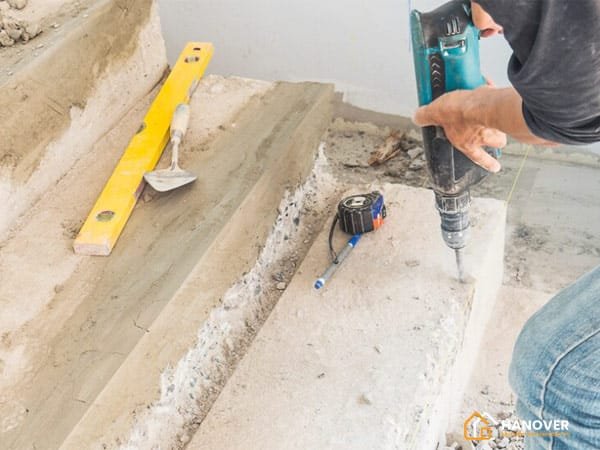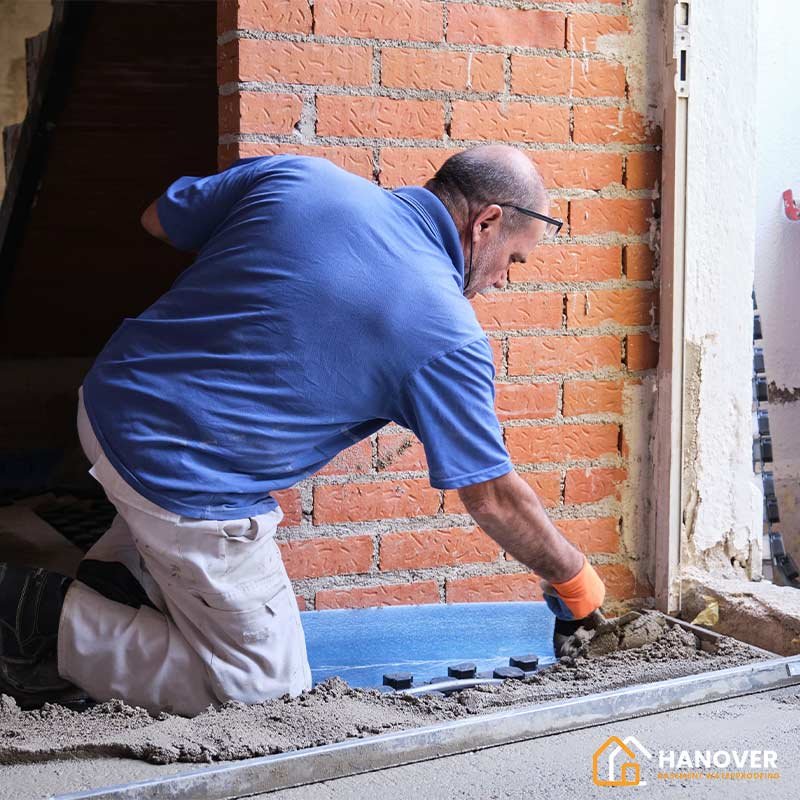A crumbling foundation is a serious structural concern. If left unchecked, it can compromise the load-bearing capacity, cause wall misalignment, and allow moisture intrusion. These issues are common in areas like Hanover, PA, where seasonal freezing and thawing weaken concrete surfaces over time.
You may notice:
- Flaking concrete, also known as spalling
- Horizontal cracks along basement walls
- Powdery residue called efflorescence
- Moisture stains or standing water near wall edges
These signs often point to subsurface water pressure, freeze damage, or aging construction materials.
Why Immediate Action Is Important
A compromised foundation wall can rapidly deteriorate, especially in humid summer months or icy winters typical in south-central Pennsylvania. Early repairs are typically more affordable and less invasive than full structural replacement. According to the American Society of Civil Engineers, small repairs that cost under $1,000 could prevent $10,000+ worth of structural failures if ignored.
Step 1: Inspect the Foundation Thoroughly
Perform a Visual Assessment
Begin with a systematic visual inspection of all exposed foundation surfaces. Walk around the property and look for:
- Hairline cracks under 1/8 inch
- Larger structural cracks (more than 1/4 inch wide)
- Bulging or bowed walls
- Crumbling mortar in block foundations
Use a tape measure, digital level, and flashlight for precise evaluation. For basements, check behind insulation panels, around sump pump pits, and near window wells.
Check for Environmental Triggers
Document environmental contributors such as:
- Downspout discharge near walls
- Poor drainage slope
- Soil erosion
- Tree root interference
If you’re seeing repeat puddles or rising damp, learn why your basement keeps flooding and how to fix it with practical, localized drainage strategies.
Local conditions in Hanover, PA often involve clay-heavy soil and inconsistent rain runoff, which contribute to foundation instability.
Monitor Crack Movement
Mark suspicious cracks with pencil lines and dates, then revisit weekly to measure movement. A widening crack is a clear sign of ongoing structural stress or hydrostatic pressure. For best accuracy, consider installing crack monitors—plastic gauges fixed across the crack.
Step 2: Determine Repair Type Based on Foundation Material
Concrete Block vs. Poured Concrete
A concrete block foundation is common in mid-century homes in Hanover. It tends to fail at the mortar joints, leading to stair-step cracking. Poured concrete foundations, used in more recent homes, fail via horizontal or diagonal cracking due to pressure buildup or shrinkage.
Match Repair Method to Problem Type
- Minor surface flaking → Apply concrete resurfacer
- Crack under 1/4 inch → Seal with epoxy injection
- Expanding crack → May need urethane grout or carbon fiber reinforcement
- Bulging wall → Requires steel beam bracing or wall anchors
Choose the repair based on:
- Crack size and direction
- Depth of damage
- Presence of moisture
Local repair specialists can be found via Pennsylvania’s Home Improvement Consumer Protection Act registry, ensuring all contractors are licensed.
Learn more about common structural repair options in our guide on foundation repair methods used in Hanover homes.
Step 3: Prepare the Work Area for Foundation Repair

Clear the Perimeter
Before beginning repairs, clear away any plants, mulch, or debris around the damaged foundation wall. Use a spade, landscaping rake, and pressure washer if necessary. The goal is to expose at least 12 to 24 inches of foundation wall for visible and physical access.
For interior repairs, remove any drywall, vapor barrier, or insulation adjacent to the problem area. Use drop cloths and wear protective gear to avoid exposure to mold spores or lead paint, especially in homes built before the 1970s.
Ensure Surface Dryness
Foundation walls must be completely dry for bonding agents, epoxies, or mortars to adhere correctly. Use fans, dehumidifiers, or wait for dry weather windows, particularly in Hanover’s humid months from June through August.
Step 4: Apply the Correct Repair Method
For Minor Surface Crumbling
When surface deterioration is limited to chipping concrete or shallow flaking, follow these steps:
- Clean the area using a wire brush and shop vacuum to remove loose particles.
- Dampen the surface lightly (but not soaked).
- Apply a concrete resurfacer (such as Quikrete Recap) with a steel trowel, feathering the edges.
- Allow to cure for 24–48 hours, shielding from direct sun and moisture.
This method restores appearance and prevents further degradation from rain and freeze cycles.
For Cracks Less Than 1/4 Inch
- Use a masonry chisel to open the crack slightly and remove debris.
- Insert epoxy crack injection ports every 6–10 inches.
- Seal the crack surface with epoxy paste, leaving ports exposed.
- After drying, inject low-viscosity epoxy resin with a dual-cartridge caulking gun, starting from the lowest port upward.
This solution structurally bonds the crack and prevents water intrusion. For improved adhesion in cold Hanover climates, use products rated for low-temperature curing.
For Cracks Greater Than 1/4 Inch or Active Movement
- Apply urethane grout injection for flexible sealing
- Reinforce with carbon fiber straps placed vertically along the cracked wall
- Use steel braces for walls with bowing over 1 inch inward
These require precise anchoring into floor joists and may necessitate professional assistance. Use licensed pros for evaluation.
Step 5: Reinforce Mortar Joints in Block Foundations
If you’re working with a block foundation, deteriorated mortar joints are a common cause of crumbling. The repair process is called repointing.
- Remove old mortar to a depth of 3/4 inch using a grinder or masonry chisel
- Vacuum dust thoroughly
- Mix fresh Type N mortar (ideal for exterior walls)
- Use a pointing trowel to insert mortar, pressing it into joints
- Tool the surface with a jointing tool for smooth finish and weather resistance
Cure the area for 48–72 hours, misting lightly for moisture retention in dry weather.
In Hanover, repointing is often needed in older homes built before 1955, where lime-based mortars have decayed due to freeze-thaw exposure.
Step 6: Address Moisture and Prevent Recurrence
Even the best repairs fail if water intrusion isn’t managed. Take these steps:
- Extend downspouts at least 6 feet away from the foundation
- Ensure grading slopes away from the home (minimum 1 inch per foot for 6 feet)
- Install or maintain French drains or interior drain tile systems
- Seal exterior walls with elastomeric waterproof coatings
Use products like Drylok Extreme or Sika Bituminous Coating, which resist hydrostatic pressure. Apply at least two coats with a roller or sprayer.
Improving water flow outdoors is crucial—but also check beneath the home. Here’s how to keep your crawl space dry year-round to protect from sub-slab vapor issues.
Step 7: Consider Professional Foundation Repair Services
When to Call a Structural Engineer
Engage a structural engineer when:
- Cracks exceed ½ inch or show diagonal orientation
- Walls are bowed inward more than 1 inch
- Multiple sides of the foundation show signs of distress
- Waterproofing efforts fail to stop leaks
A structural engineer will assess load paths, subgrade conditions, and settlement behavior, often using tools like laser levels, soil probes, and ground-penetrating radar.
The resulting inspection report is required for permit approvals or insurance claims in many municipalities, including those in Hanover, PA.
Explore our foundation repair services in Hanover, PA for licensed support and long-term reinforcement.
Choosing a Local Licensed Contractor
Verify licensing through the Pennsylvania HICPA database. Look for contractors with:
- Foundation repair specialization
- Warranties on workmanship
- Familiarity with York County soil types
- Proper insurance and bonding
Request references and confirm they have experience with your foundation type and repair scope. This is especially vital when opting for:
- Steel I-beam bracing
- Helical pier installation
- Drainage system retrofits
Step 8: Obtain Permits and Follow Local Building Codes
In Hanover Borough, permits are often required for:
- Structural modifications
- Excavation near the foundation
- Waterproofing below grade
- Load-bearing reinforcement installations
To ensure compliance:
- Contact the Hanover Borough Building Department
- Reference Pennsylvania Residential Code (IRC 2021) standards
- Submit engineer-certified plans when performing major alterations
Skipping permits may result in fines, forced rework, or insurance denial. Always confirm with local authorities before starting large-scale projects.
Step 9: Implement Long-Term Maintenance and Monitoring
Once repairs are complete, maintain your foundation by:
- Inspecting drainage flow each season
- Keeping gutters clean and directing runoff away from the house
- Monitoring old crack sites quarterly
- Applying water-repellent sealers every 2–3 years
Use a foundation logbook to track:
- Repair dates
- Contractor contacts
- Warranty terms
- Seasonal observations
This simple habit helps homeowners anticipate issues early and reduces the risk of expensive structural damage.
Frequently Asked Questions
How long does it take to repair a crumbling foundation?
The time it takes to repair a crumbling foundation depends on the extent of the damage. Minor repairs, such as filling minor cracks, can take a few hours to a day. However, repairs could take several days or even a week for more significant issues, such as large cracks or structural damage. It’s best to consult a professional to get a more accurate timeline based on your situation.
How much does it cost to repair a crumbling foundation?
The cost of repairing a crumbling foundation varies depending on the severity of the damage and the methods used for repair. Minor repairs cost anywhere from $500 to $1,500. In contrast, more extensive repairs, like structural reinforcement or underpinning, can range from $2,000 to $10,000. A professional’s detailed estimate will help you better understand the costs involved.
Can a crumbling foundation be completely fixed?
A crumbling foundation can be repaired and restored to a solid, stable condition, provided the right materials and techniques are used. For minor damage, such as small cracks, repairs are relatively straightforward. However, more significant issues require extensive work, such as strengthening or even underpinning the foundation. With proper maintenance, you can prevent further crumbling and maintain the integrity of your home.
Will repairs prevent future damage?
While repairs can stop the immediate damage and strengthen the foundation, addressing underlying issues like moisture control and soil movement is essential to prevent future damage. By maintaining proper drainage, regularly inspecting the foundation, and controlling moisture levels, you can reduce the risk of future crumbling and extend the life of your foundation.
What causes foundation walls to crumble in Hanover, PA?
Freeze-thaw cycles, poor grading, clay-heavy soils, and aging materials are common contributors in the Hanover region. When water penetrates the foundation and freezes, it expands, cracking and weakening the structure over time.
Can I repair a crumbling foundation myself?
Small surface repairs, minor cracks, and joint repointing can be done as DIY with proper tools and care. However, significant bowing, large cracks, or multi-wall issues require professional evaluation and intervention.
How much does foundation repair cost in Hanover?
Minor repairs such as crack injections range from $500–$1,200. Reinforcements or waterproofing can cost $3,000–$10,000. Full wall reconstruction or underpinning can exceed $20,000, especially if excavation is involved.

